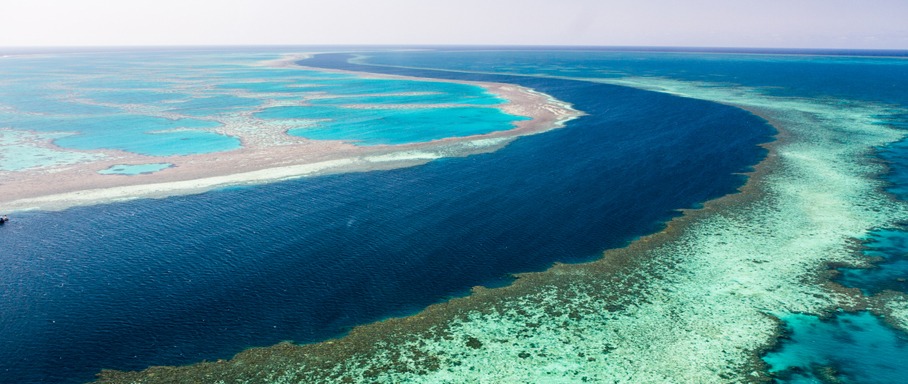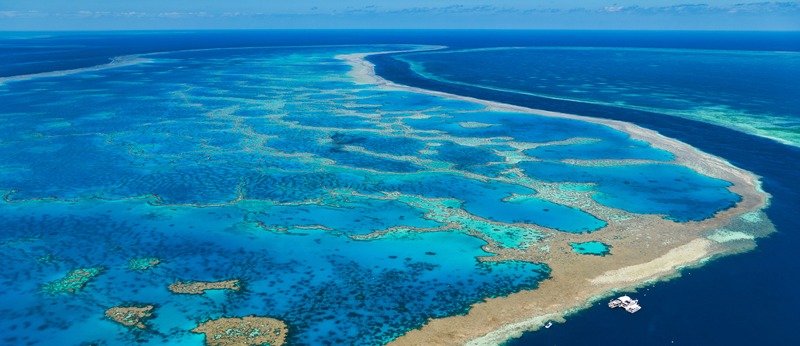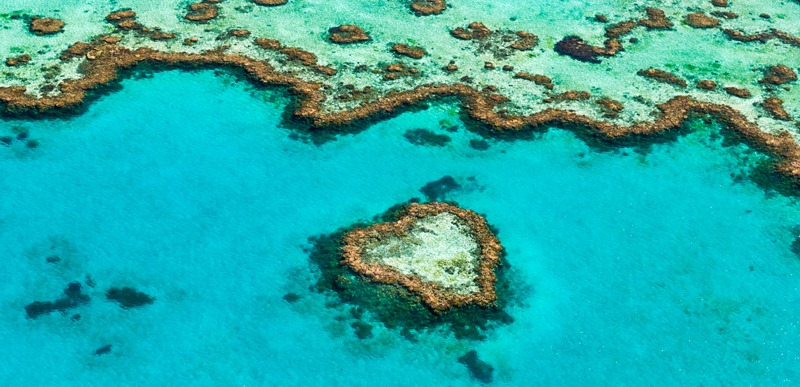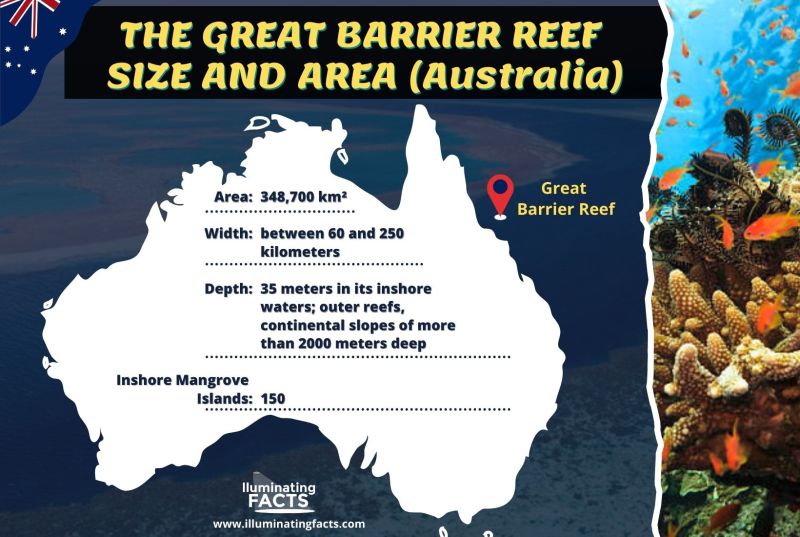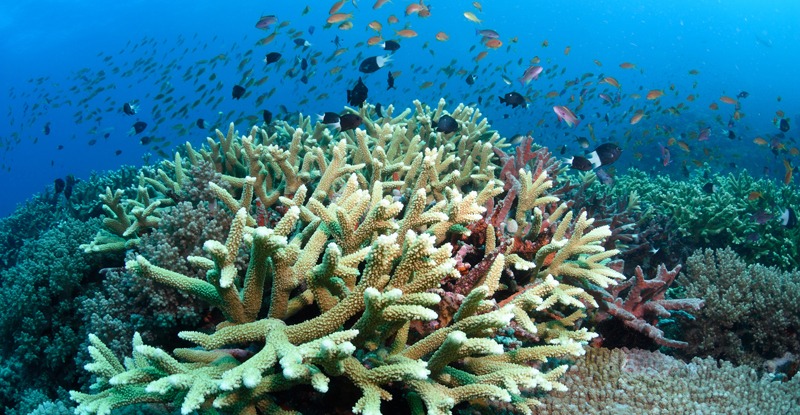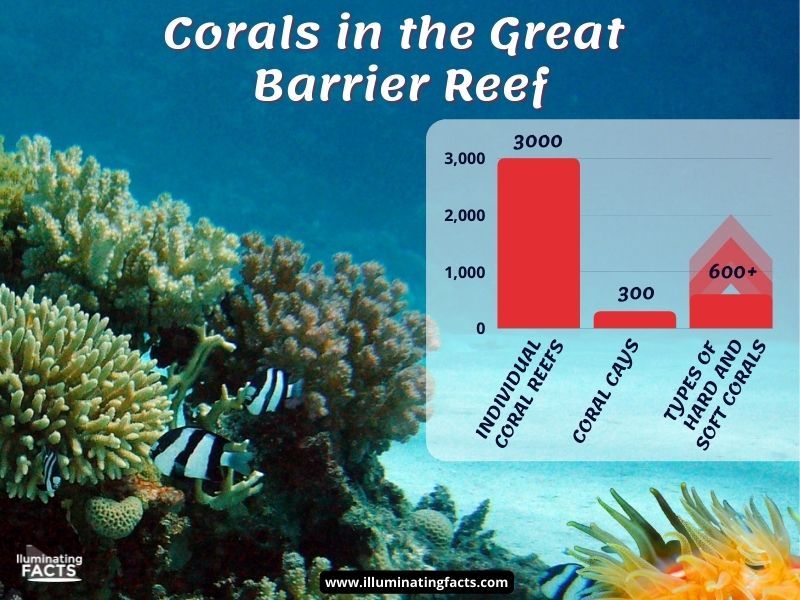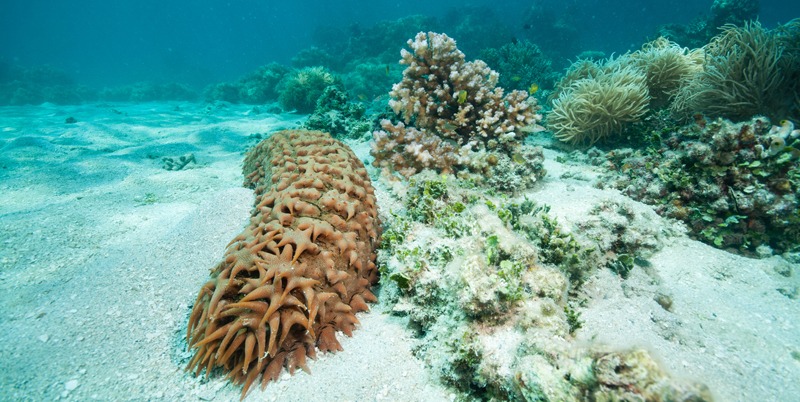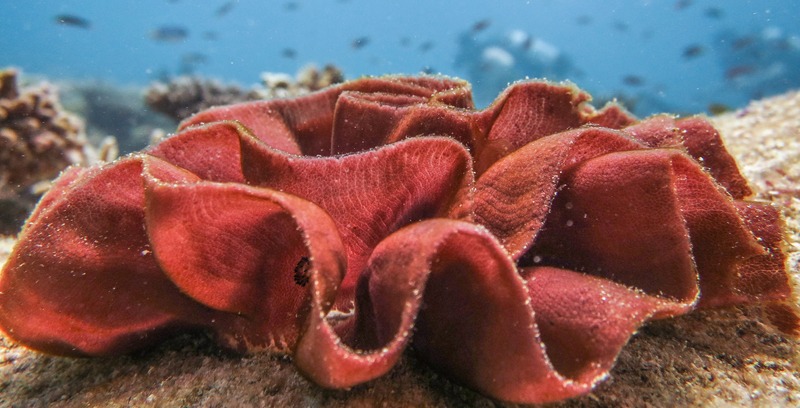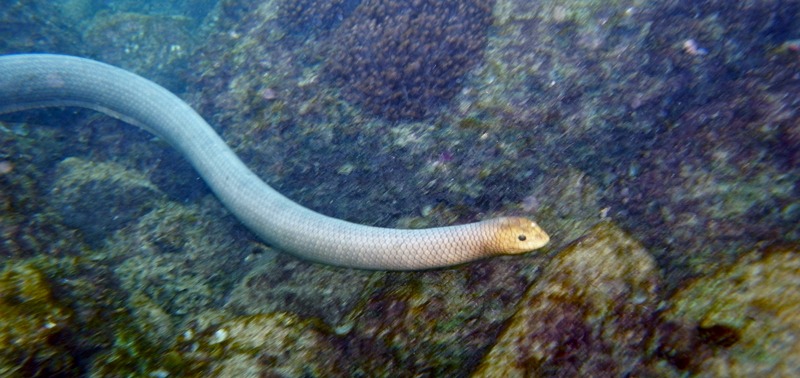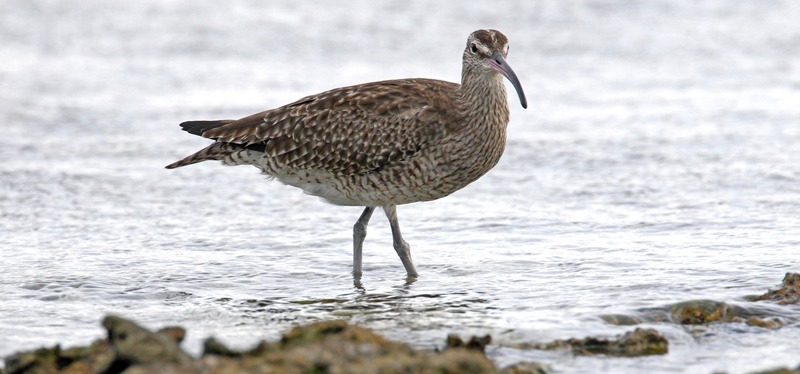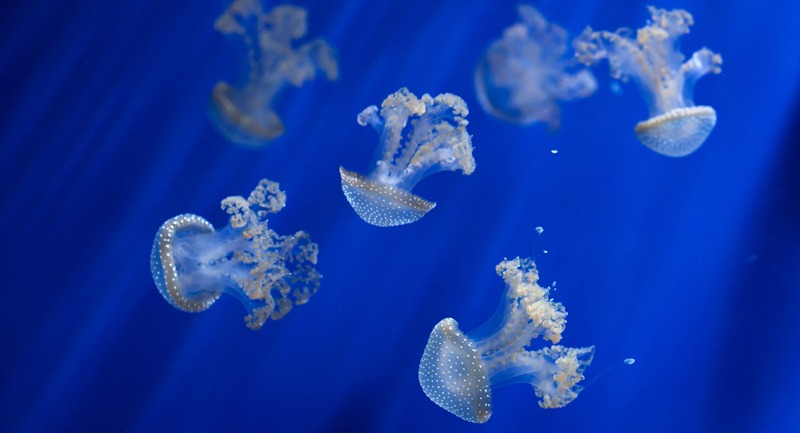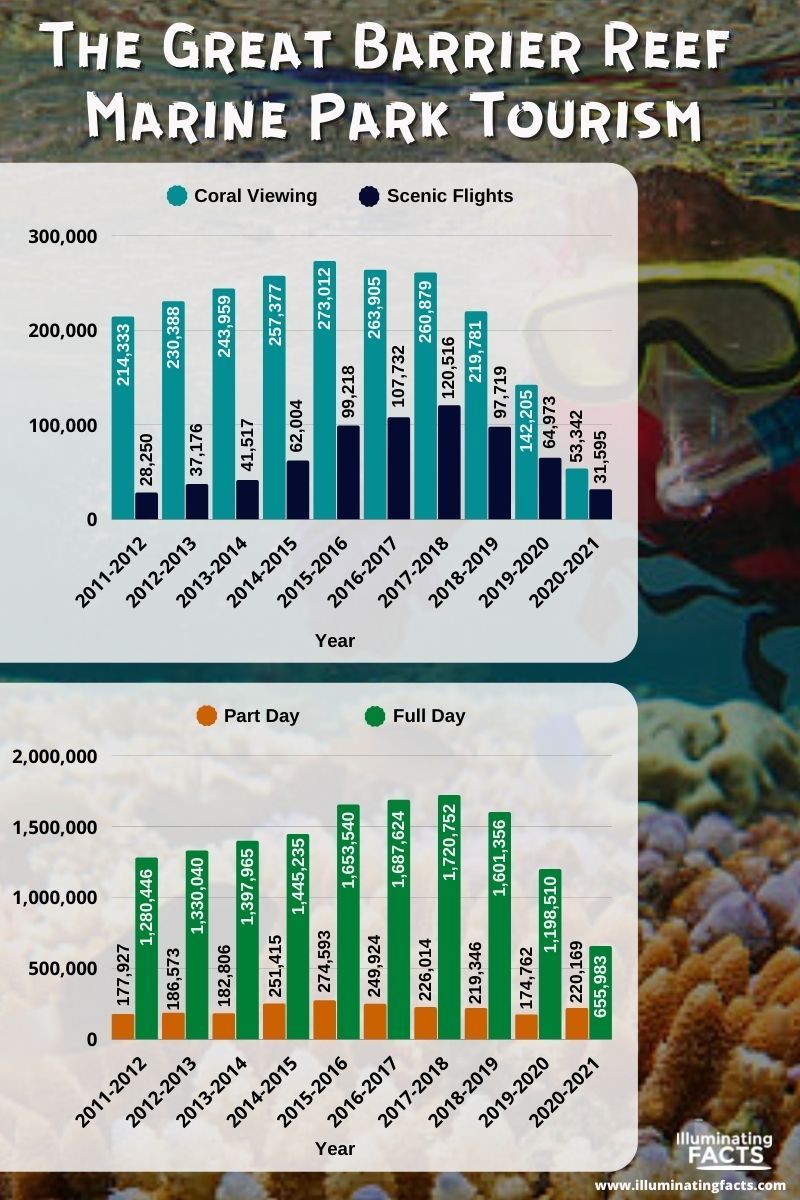Background
Coral reefs are known to be large underwater structures that are made of skeletons of colonial marine invertebrates referred to as corals. The coral species that create reefs are called hermatypic or “hard” corals. These corals extract calcium carbonate from seawater to make a hard, durable exoskeleton that protects their soft, sac-like bodies. However, “soft” corals are not involved in building reefs. They are flexible organisms that usually resemble plants and trees.
Each coral in a reef is called a polyp. Coral polyps live on the calcium carbonate exoskeletons of their ancestors, adding their own to the existing coral structure. As time passes, the coral reef slowly grows, one small exoskeleton at a time, until they become large features of the marine environment.[1]
You can find many corals all over the oceans around the world. Among these, the largest coral reef system in the world is found in Australia, the Great Barrier Reef. The reef extends to more than 1,500 miles long or 2,400 kilometers. It is home to more than 9,000 known species and around 3,000 individual reefs of coral. It is also among the seven natural wonders of the world.
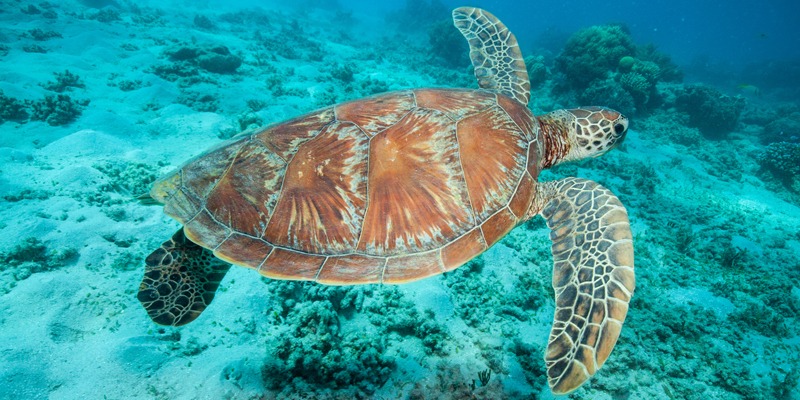
A Green Turtle Swimming
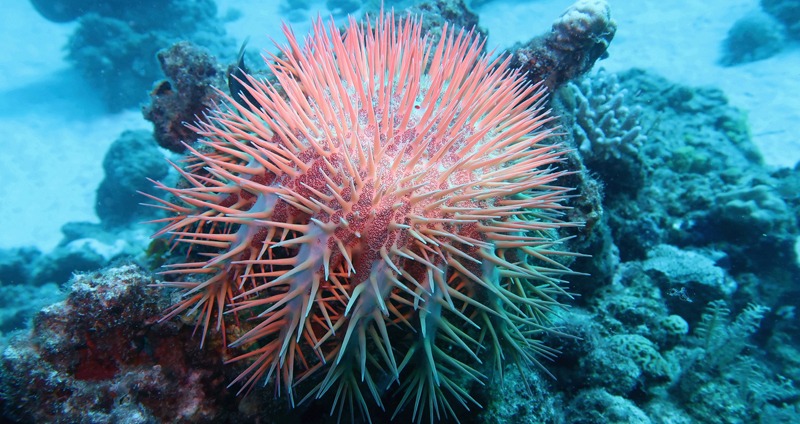
A Crown-of-thorns Starfish

A School of Fish
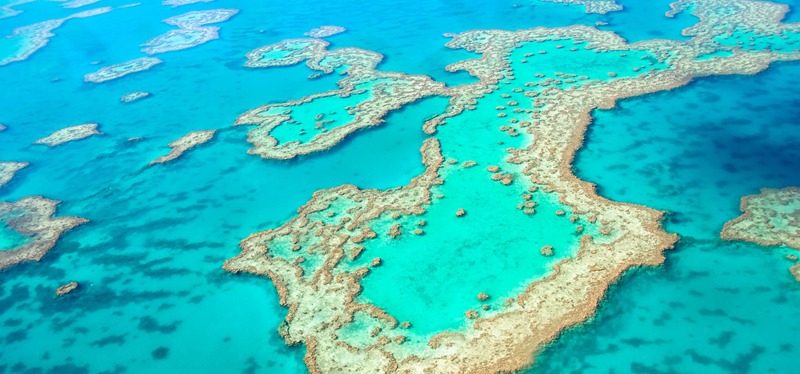
The Great Barrier Reef from above
This post is perfect if you want to learn more about the Great Barrier Reef. This article includes much information regarding the largest coral reef system in the world. This includes the history of the Great Barrier Reef, its size and area, corals, different species, tourism rate, and the threats it faces. Also included as some of the most interesting facts about the Great Barrier Reef that you need to know.
The History of the Great Barrier Reef
The Great Barrier Reef has a long and diverse history, as many generations of coral have built a habitat that was eventually discovered and settled by people. It is an extremely ancient and massive host of living things, made up of living coral growing on dead coral, dating back as many as twenty million years. This means that many generations of dead coral have built themselves into great walls of stone covered in different living organisms, including coral, anemones, algae, fish, turtles, sponges, works, snakes, plants, and animals.
There might be no direct physical evidence, but the first human contact with the reef must have happened some time ago. Most of us know that Aboriginal people occupied great parts of the Australian continent for about 40,000 years. They have fished and hunted its waters and navigated between the island of the reef region. During most of those times, during the periods of glacial activity, the range of the Great Barrier Reef was dry with large flat coastal plains. It is presently at a depth of less than a hundred meters below sea level.[2]
Early Discovery
It is widely believed that the east coast of Australia was first sighted around 1522 by a Portuguese expedition. This was possibly led by Cristovao de Mendonca. The west coast of Cape York Peninsula was chartered in 1606 by Willem Jansz in the Duyfken. This started 40 years of maritime exploration in Australian waters by the Dutch. Later on, the islands of Torres Strait were sighted by Luis de Torres while he was sailing from east to west along the southern coast of Papua.
The French have the earliest documentary evidence of Europeans sighting the Great Barrier Reef. On June 6, 1768, Louis de Bougainville approached Australia from the east, commanding the ships La Boudeuse and L’Etoile, coming across Bougainville Reef near Cooktown. However, confronted by rough surf in the open ocean and being short of food, they turned north toward Asia along the north coast of New Guinea, missing Australia.
From May to August 1770, the Endeavor, under James Cook, sailed the length of the Great Barrier Reef. Most of the journey was made well inshore, seeing just a little of the Reef. However, on June 11, his party became intimately acquainted with the reef when the ship struck Endeavor Reef, north of Cape Tribulation. With this, they were forced to stay for six weeks, repairing the ship on the shore at the side of modern Cooktown.
Due to the unexpected scenario, Cook and his scientists, Joseph Banks, Daniel Solander, and four illustrators, were given a chance to do little direct scientific observation of the Reef. With this, the international scientific community knew that the Reef existed and was of great range.
Cook decided to try for the open sea when all the ship’s repairs were completed. However, they could not find any way through the natural barrier. With this, they sailed north to Lizard Island. After landing on the island, Cook and his botanist, Joseph Banks, went up to the highest point, where they saw a break in the reef large enough to let the Endeavor pass. This was later named Cook’s Passage.[2]
After James Cook’s Discovery
William Bligh on the Providence ship was the next navigator in Australia’s early history to chart the Reef. During his journey from Tahiti to the West Indies, he spent about two weeks in September charting passages through Torres Strait. In 1788, after the penal colony of Sydney was established, finding a reliable route west through the straits to the Arafura Sea and creating communication with Asia depended on the inner passage west of the Reef. Further surveys of the Torres Strait section of the reef were undertaken in 1793 by captains Bampton and Alt in the ships Hormuzeer and Chesterfield.
A period of surveying in northern Australian waters via small naval vessels ushered in the next few decades. These surveys were done to improve navigational charts for Admiralty use, as well as to investigate natural resources for future economic exploitation and to find answers to scientific questions.
From 1801 to 1803, Matthew Flinders surveyed the whole Australian coastline. At one point, he walked on what he called the “Extensive Barrier Reefs.” He was the one who plotted a safe passage by sending small boats ahead to sound the depths. Today, this passage is still called the Flinders Passage.
In 1819 and 1820, hydrographer Philip Parker King, commanding the Mermaid and the Bathurst, carried on the methodical task of charting much of the north Reef accurately and in detail for the first time.
Currently, studies about the Great Barrier Reef are done on a much closer level, exploring the reef’s makeup, species, how they live and interact, and more. But you also need to note that there is still evidence of an earlier period of discovery that is evident on the Great Barrier Reef, having 30 shipwrecks sites of historic importance known to exist.[2]
The Size and Area of the Great Barrier Reef
The Great Barrier Reef makes up around 10% of the world’s coral reef ecosystems. It is also among the best-known and most complex natural systems on Earth. It is the sea country home for the first Australians, including over 70 Traditional Owner groups whose connections to the marine environment date back more than 60,000 years. Currently, the Reef is a Marine Park and World Heritage Area that supports various commercial activities. It attracts millions of visitors yearly to enjoy the beauty above and below the water.
The Great Barrier Reef extends more than 14 degrees of latitude, from shallow estuarine areas to deep oceanic waters. This vast expanse is a unique range of ecological communities, species, and habitats. All of these make the Reef one of the most complex natural ecosystems in the world.[3] Below are some numbers about the size and area of the Great Barrier Reef.
To give you more ideas about how big the Great Barrier Reef is, here are some comparisons:
- It is bigger than Tasmania and Victoria combined.
- It is bigger than Switzerland, Holland, and the United Kingdom combined.
- It is about the same area as Italy, Malaysia, or Japan.
- It is about half the size of Texas.
- It is a bit smaller than the whole Baltic Sea.
- The Great Barrier Reef Marine Park could fit into Hudson Bay three and a half times.
- Great Britain could fit in the Great Barrier Reef Marine Park about 1.6 times.
- The Great Barrier Reef would cover 67% of France’s total length of coastlines.
- It would also cover the distance from Rio de Janeiro to the mouth of the Amazon River.
- It could cover 98.6% of Germany.
- It could be laid down 1.4 times from North to South within India.[3]
Corals in the Great Barrier Reef
The astounding array of coral on the Great Barrier Reef is responsible for giving it bright and beautiful colors, which makes it internationally popular. There are many different kinds of coral on the Great Barrier Reef, including hundreds of species of both hexacorals or hard corals and octocorals, such as soft corals, sea pens, sea fans, and blue corals.
As mentioned earlier, a coral reef is an underwater ecosystem of reef-building corals. The Great Barrier Reef is made of around 3000 coral reefs. On the other hand, a coral cay is an island formed from sediments from the reef on which it sits and swept by refracted waves to a center point on the reef flat where they are deposited. It may remain intertidal and lack vegetation, but it can build up to be above sea level, acquire a vegetation cover, or become partially lithified with time. There are about 300 coral cays in the Great Barrier Reef.
Hexacorals / Hard Corals
Hard corals function as building blocks for the Reef. They are made when coral polyps create limestone skeletons to support themselves. A hard coral can be made of hundreds, thousands, or even millions of individual coral polyps that live together as a colony. They usually have six or multiples of six smooth tentacles.[4]
Octocorals / Soft Corals
Soft corals, however, are flexible as they do not have a solid skeleton. This is why sometimes people mistake them for plants. These corals are supported by small limestone spike-like structures that are called spicules. In addition to their swaying bodies and jelly-like characteristics, they also consist of eight tentacles on each polyp. The tentacles feature a feathery appearance, unlike hard corals that have smooth tentacles. Soft corals are also brighter in color.[4]
Different Animals in the Great Barrier Reef
The Great Barrier Reef is home to more than 2,900 coral reefs, 600 continental islands, 300 coral cays, and thousands of animals. If you are curious about what animals you can find when you visit the largest coral reef in the world, below are some of the indigenous creatures that inhabit the world’s most complex ecosystems.
Hard Coral
You will be able to find about 360 species of hard coral in the Great Barrier Reef. These include brain coral, tabletop coral, bottlebrush coral, needle coral, and bubble coral. These are also known as stony corals. They collect in shallow tropical waters and help build coral reefs. They grow in different masses, such as plates, branches, and mounds. As the colonies of coral die, new ones grow on the limestone skeletons of their predecessors, building the three-dimensional architecture of the reef.
Sponges
These are not as visible as other animals, but around 5,000 species of sponges are along the Great Barrier Reef. These animals perform important ecological functions that pave the way for new generations while maintaining the overall health of the reef. They are near the bottom of the food chain, giving nutrients to more complex animals. In addition, some species of sponges can also help recycle calcium carbonate from dying corals, which in turn end up being incorporated into the bodies of diatoms and mollusks.
Starfish and Sea Cucumbers
There are 600 plus species of echinoderms in the Great Barrier Reef. These include sea cucumbers and starfish. They are also essential in the ecosystem as they constitute an essential link in the food chain and help maintain the overall ecology of the reef. However, this is an exception, which is the crown-of-thorns starfish, as it feeds on the soft tissues of corals, which causes drastic declines in the population of corals if left unchecked. The only solution is to maintain the populations of the natural predators of the crown of thorns, including the pufferfish and giant triton snail.
Mollusks
Mollusks include species like oysters, clams, and cuttlefish. According to marine biologists, there are around 5,000 to 10,000 species of mollusks that can be found in the Great Barrier Reef. The giant clam, weighing about 500 pounds, is among those most visible. This ecosystem is also popular for squids, sea slugs, and cowries.
Fish
Over 1,600 species of fish live in the Great Barrier Reef. They range from small gobies and larger bony fishes like potato cods to massive cartilaginous fish like whale sharks and manta rays. Some of the most abundant fish on the reef are tusk fish, wrasses, and damselfish. Aside from those, there are also seahorses, hawkfish, angelfish, surgeonfish, triggerfish, pufferfish, coral trout, and more.[5]
Sea Turtles
Six species of sea turtles frequent the Great Barrier Reef. These are the flatback turtle, leatherback turtle, green turtle, hawksbill turtle, loggerhead turtle, and Pacific ridley turtle. Hawksbill, green, and loggerhead turtles usually nest on coral cays. On the other hand, flatback turtles prefer to live on continental islands. However, these turtles are currently classified as endangered or vulnerable species.
Sea Snakes
At present, there are about 14 sea snakes that are endemic to the Great Barrier Reef. These include the banded sea krait and the large olive sea snake. All species of sea snakes are venomous, but they are much less threatening to humans than terrestrial snakes like cobras and copperheads.
Birds
Wherever there are mollusks and fish, there will be pelagic birds. These birds nest on nearby islands or the Australian coastline. They venture out to the Great Barrier Reef for frequent meals. Some of the most common bird species that you may find on the reef are the silver gull, while-bellied sea eagle, sacred kingfisher, bar-shouldered dove, and Capricorn silver eye. All of these birds rely on nearby reefs for food and nutrition.
Dolphins and Whales
The warm waters of the Great Barrier Reef make it an ideal destination for around 30 species of whales and dolphins. Some stay for the whole year, while others swim to the region to give birth and raise young. Some just pass through during their yearly migrations. The humpback whale is the most spectacular cetacean on the Great Barrier Reef. You can also spot the five-ton dwarf minke whale and the bottlenose dolphin when you visit.
Jellyfish
In the Great Barrier Reef area, there are more than 100 species of jellyfish. These include the stinging blue bottles and box jellyfish. There is also the Irukandji jellyfish, the tiniest but most venomous jellyfish in the world.[5]
Great Barrier Reef Tourist Numbers
Tourism visitation to the whole Great Barrier Reef Marine Park until June 30, 2021, was reported at 1,134,500 visitor days. It was less than about 52% compared to the previous 8-year average.[5] Below is a graph on visitation by financial year in the Great Barrier Reef Marine Park from 2011 to 2021.
The information on the chart above is from the Great Barrier Reef Marine Park Authority. The numbers include full-day visits, part-day visits, viewing activities, and scenic flights. The best measure of the general tourism trend in the Great Barrier Reef Marine Park is the full-day visits. Full-day visits pertain to a day trip of more than three hours. Part-day visits, on the other hand, are trips that are less than three hours.
The exempt visits are those passengers who are not required to pay the Environmental Management Charge. These include children under 4 years of age and people engaged in the tourism industry who visit for trade familiarization. Scenic flights are passengers who are on sight-seeing flights. On the other hand, coral viewing is a standalone activity involving visitors viewing marine life from a glass-bottom boat or a semi-submersible boat.[5]
According to GBRMPA, the average percentage of quarterly logbook returns completed for the 2020-2021 financial year was 97.12%.[6] Here are the per quarter breakdowns:
- July to September 2020 – 98.39%
- October to December 2020 – 97.96%
- January to March 2021 – 96.60%
- April to June 2021 – 95.53%
With these data, we can conclude that almost 2 million tourists visit the Great Barrier Reef each year.
The Threats to the Great Barrier Reef
The Great Barrier Reef is more than just a tourist attraction. As an ocean structure, it also offers coastal protection against storms and big waves. However, the Reef today is highly vulnerable. It has lost about half of its coral cover in the past three decades. Pollution has caused deadly starfish outbreaks, and global warming has produced terrible coral bleaching. In addition to that, coastal development also looms as a major threat.
- Coral Bleaching: This results from global warming caused by mining and burning fuels such as coal. Global warming is a phenomenon that heats the oceans. The corals will bleach and die if the water stays too hot for a very long period.[7] Based on studies, coral bleaching has affected 98% of Australia’s Great Barrier Reef since 1998. Only a small part of the world’s largest reef system remains untouched.[8]
- Poor Water Quality: The declining marine or coastal water quality, which is influenced by land-based run-off, is among the most significant threats to the long-term health and resilience of the Great Barrier Reef. Some factors are the increasing sediment, nutrients, and contaminants entering coastal waters in run-off from industrial, agriculture, and urban land uses. Also, the rising seawater temperatures and increasing seawater acidity that come with climate change are factors.[9]
- Ever-Increasing Waste: Tons of plastic waste end up in the ocean yearly. These smother coral and kill wildlife. In addition to that, it also causes sediment run-off, which, as mentioned above, ruins the reef’s water quality. This makes the reef more vulnerable to local stresses, including the crown-of-thorns starfish.[10]
- Crown-of-Thorns Starfish: The outbreaks of coral-eating crown-of-thorns starfish are also a huge concern. These are native to the reef, but when found in large numbers and when coral is under stress, they can destroy corals by eating their living tissue or skin. According to research, coral cover on surveyed reefs fell by 50% from 1985 to 2012, and crown-of-thorn starfish were responsible for almost half of this decline.
Climate change is the biggest threat to the Great Barrier Reef. But there are other threats, such as the impacts of fishing, illegal fishing, and poaching. As the years pass, the threat of future damage increases, as the Great Barrier Reef is now under greater stress than in the past years, reducing its ability to recover.
According to experts, cutting greenhouse gas emissions is the only way to save the reef. Based on the United Nations, even if the world contains global warming to a 1.5C rise, about 90% of the corals in the world will still not survive. With this, Australia has pledged a 2030 emissions goal of a 26% cut on 2005 levels. However, it resisted pressure to commit to a net-zero emissions target by 2050.[11]
Interesting Facts About the Great Barrier Reef
If you want to learn more about the largest coral reef system in the world, below are some of the interesting facts about the Great Barrier Reef that you need to know:
- The Great Barrier Reef is the only place where two UNESCO World Heritage Sites meet. It’s because the Reef hugs the Wet Tropics coastline, the oldest rainforest in the world.
- The Great Barrier Reef is bigger than Victoria and Tasmania combined, stretching 2,300 kilometers along two-thirds of the Queensland coast.
- A third of the world’s corals can be found in the Great Barrier Reef.
- The Great Barrier Reef is home to more than 5,000 marine and mammal species.
- Some of the most famous dive sites are along the Great Barrier Reef.
- The coral spawning season occurs every November. It is when the Great Barrier Reef releases eggs and sperm into the ocean simultaneously. It is key in helping the reef grow and repair.
- The Great Barrier Reef is also known to be the largest living thing on Earth that is visible from outer space.
- It is composed of thousands of reefs and hundreds of islands.
- It is home to 600 types of hard and soft coral.
- About 10% of the world’s total fish species can be found within the Great Barrier Reef.
- The Great Barrier Reef is thought to be about 20,000,000 years old.
- The Great Barrier Reef generates more than 6 billion dollars per year.
- Its size is about 70 million football fields.
- It is also home to some of the deadliest animals in the ocean, such as the Stone Fish, Box Jellyfish, and the Blue Ringed Octopus.
- The Great Barrier Reef is among the Seven Natural Wonders of the World.
- The Great Barrier Reef Marine Park was created in 2004 to protect the most precious natural treasure from damaging activities.
- Climate change and global warming are the two biggest threats to the Great Barrier Reef.
- Nine major bleaching events caused severe damage to the living corals in the Great Barrier Reef. These occurred in 1980, 1982, 1992, 1994, 1998, 2002, 2006, 2016, and 2017.
- There were at least 1,600 shipwrecks that have been identified within the perimeter of the Great Barrier Reef.
- Torres Strait Islanders and Aboriginal Australians still live in the Great Barrier Reef.
Conclusion
The Great Barrier Reef is among the world’s most captivating and astonishing natural wonders. In addition to its beauty, it is also home to thousands of wonderful marine life on earth. The Reef is also something that gives protection against big waves and storms. It is no wonder millions of people are looking into visiting and experiencing the Great Barrier Reef each year.
However, it is also quite upsetting to learn about the threats that endanger the Reef and its marine lives. Doing things that may lessen global warming and climate change may help protect the Great Barrier Reef from further decline. We hope this post helped you learn more about the Great Barrier Reef.
References
[1] Ross, R. (2018, September 24). What are coral reefs? LiveScience. Retrieved January 24, 2022, from https://www.livescience.com/40276-coral-reefs.html
[2] Great Barrier Reef.org, E. (2015, December 11). History and evolution of the Great Barrier Reef. Great Barrier Reef. Retrieved January 24, 2022, from https://greatbarrierreef.org/about-the-reef/history
[3] The Great Barrier Reef Marine Park Authority, G. B. R. M. P. A. (2020). Reef facts. GBRMPA. Retrieved January 24, 2022, from https://www.gbrmpa.gov.au/the-reef/reef-facts
[4] The Great Barrier Reef Marine Park Authority, G. B. R. M. P. A. (2020). Corals. GBRMPA. Retrieved January 24, 2022, from https://www.gbrmpa.gov.au/the-reef/reef-facts
[5] Strauss, B. (2019, October 27). Animals of the Great Barrier Reef range from corals to predators. ThoughtCo. Retrieved January 25, 2022, from https://www.thoughtco.com/animals-of-the-great-barrier-reef-4115326
[6] The Great Barrier Reef Marine Park Authority, E. (2021). Great Barrier Reef Tourist Numbers. GBRMPA. Retrieved January 25, 2022, from https://www.gbrmpa.gov.au/our-work/Managing-multiple-uses/tourism-on-the-great-barrier-reef/numbers#:~:text=Tourism%20visitation%20to%20the%20entire,reported%20at%201%2C134%2C500%20visitor%20days.&text=This%20data%20is%20vital%20to,Great%20Barrier%20Reef%20Marine%20Park.
[7] WWF.org, E. (2021). Great Barrier Reef. WWF. Retrieved January 25, 2022, from https://www.wwf.org.au/what-we-do/oceans/great-barrier-reef#:~:text=The%20Reef%20is%20highly%20vulnerable,looms%20as%20a%20major%20threat.
[8] ScienceX, S. (2021, November 4). Coral bleaching impacts 98% of Great Barrier Reef: Study. Phys.org. Retrieved January 25, 2022, from https://phys.org/news/2021-11-coral-impacts-great-barrier-reef.html#:~:text=Coral%20bleaching%20has%20affected%2098,to%20a%20study%20published%20Friday.
[9] The Great Barrier Reef Foundation, E. (2021). Poor Water Quality. Great Barrier Reef Foundation. Retrieved January 25, 2022, from https://www.barrierreef.org/the-reef/threats/poor-water-quality
[10] Citizens of the Great Barrier Reef, E. (2021). The Reef’s greatest threats. Citizens of the Great Barrier Reef. Retrieved January 25, 2022, from https://citizensgbr.org/the-reefs-greatest-threats
[11] BBC, E. (2021, July 23). Why is the Great Barrier Reef in trouble? A simple guide. BBC News. Retrieved January 25, 2022, from https://www.bbc.com/news/world-australia-57938858
[12] Pridmore, J. (2020). Facts about the iconic Great Barrier Reef. Queensland. Retrieved January 25, 2022, from https://www.queensland.com/au/en/places-to-see/experiences/great-barrier-reef/facts-about-the-iconic-great-barrier-reef
[13] SurferToday.com, E. (2020). 20 fascinating facts about the Great Barrier Reef. Surfertoday. Retrieved January 25, 2022, from https://www.surfertoday.com/environment/fascinating-facts-about-the-great-barrier-reef

